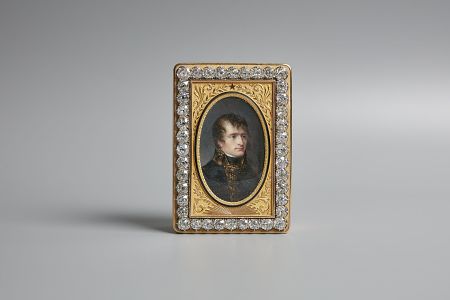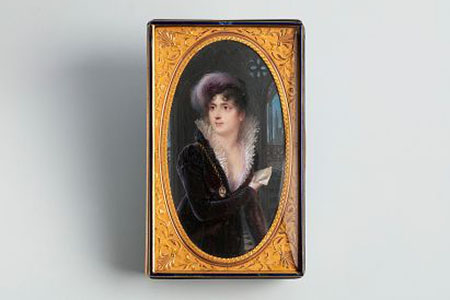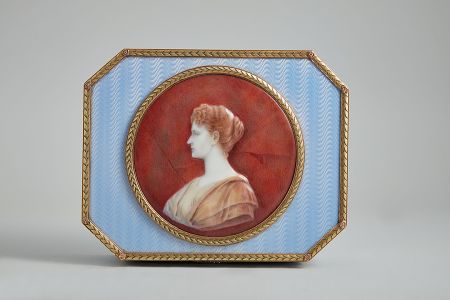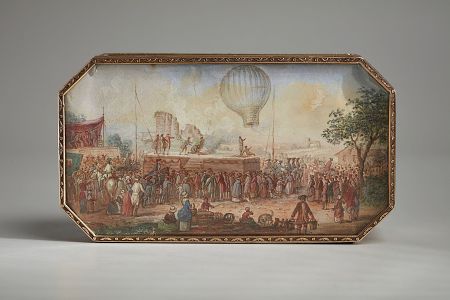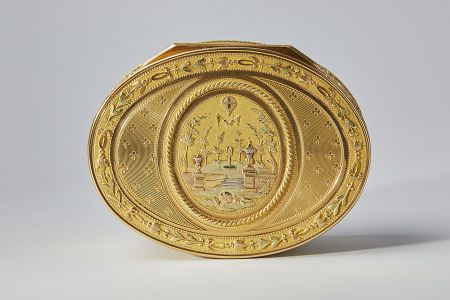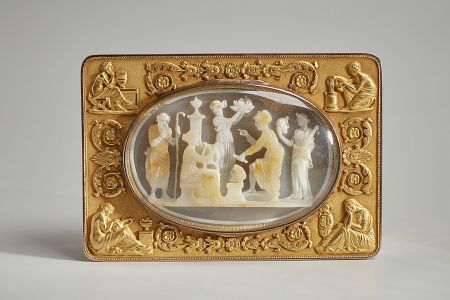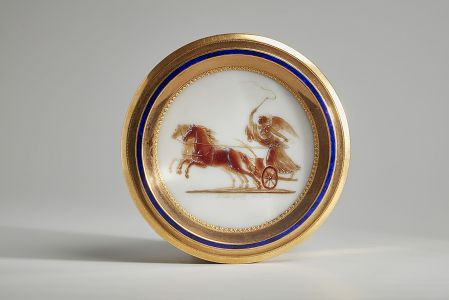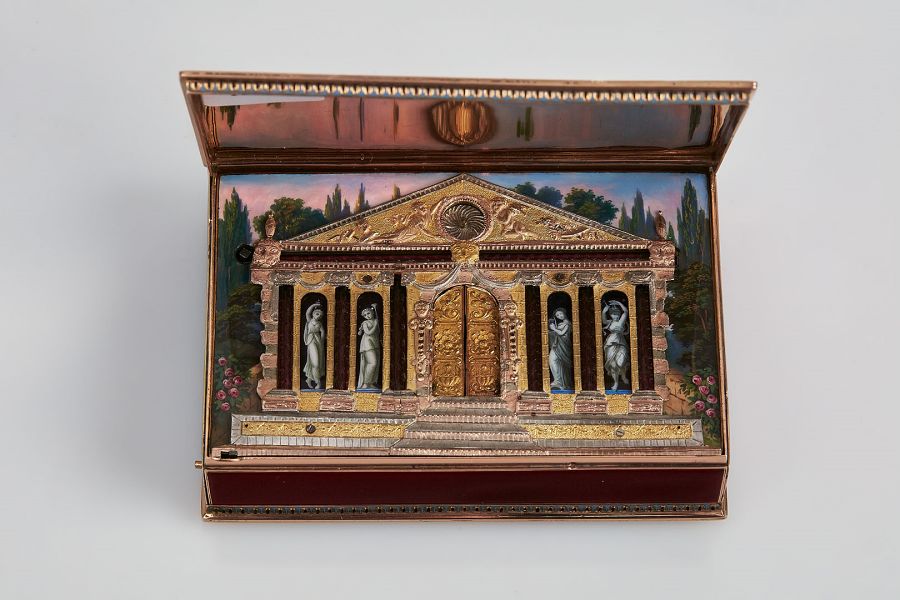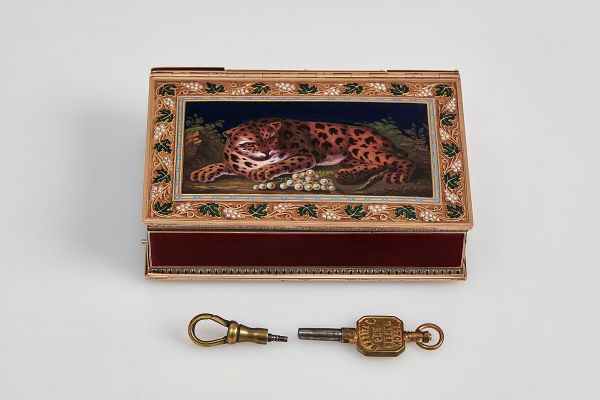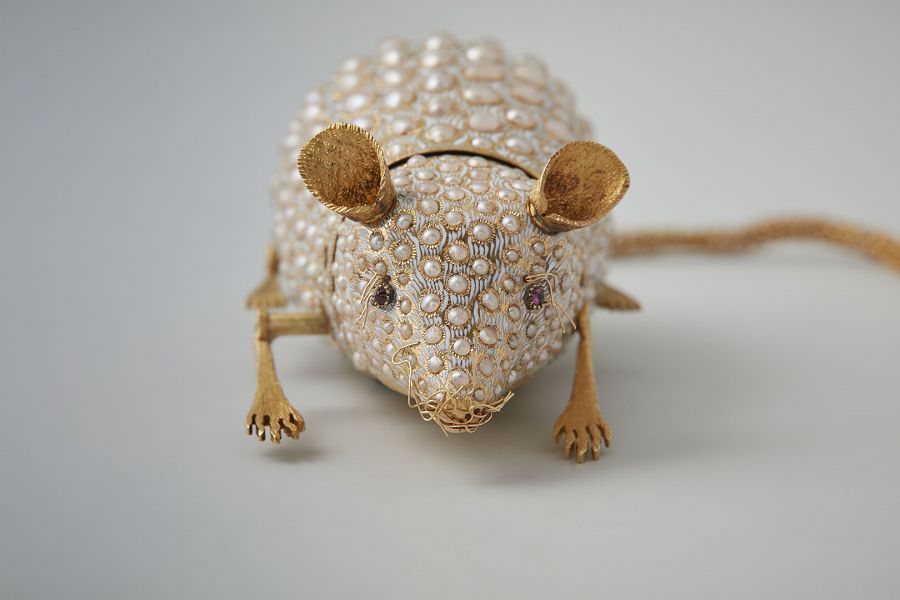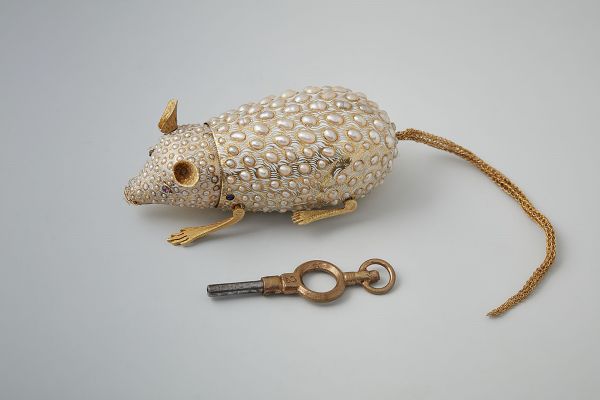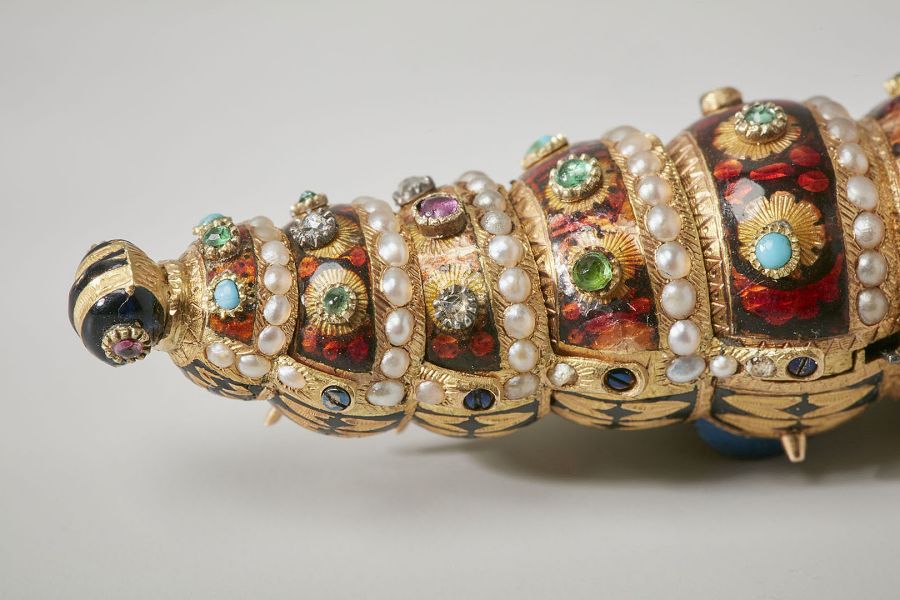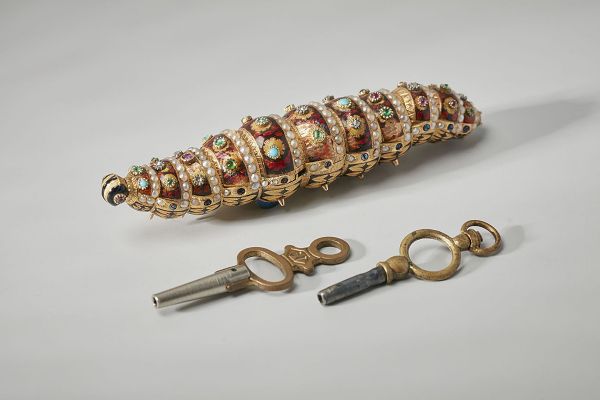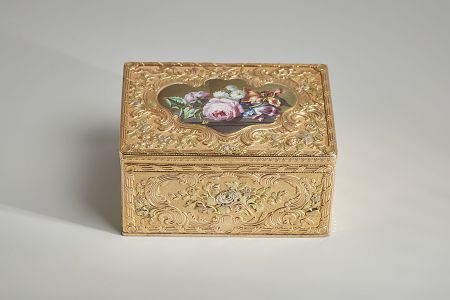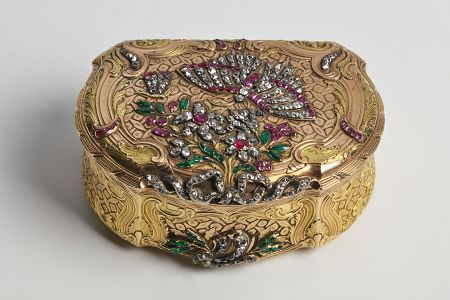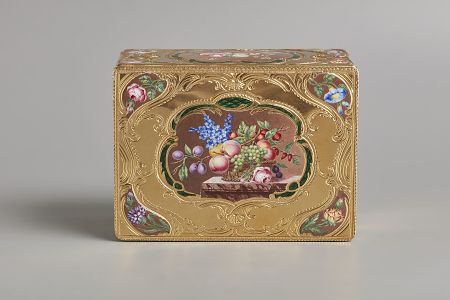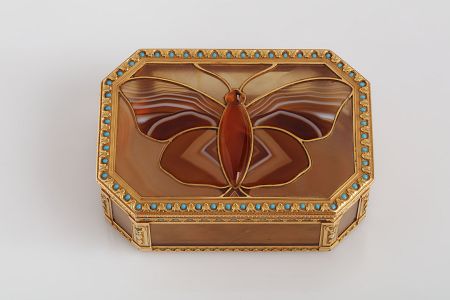This small group of snuff boxes allows the public a first opportunity to see works from an exceptional collection of objects of vertu assembled in the past two decades by David and Mikhail Iakobachvili, which is but one facet of the holdings of the Musée Collection des Arts.
When the practise of taking snuff - spiced and scented tobacco powder - developed in the late 17th century a parallel demand for receptacles to hold the powder emerged. Simple functional containers were not what the fashionable elite desired and so goldsmiths, enamellers and lapidaries were presented with a constant challenge to produce novelties that would show the owner’s refinement and wealth. Snuff boxes might be designed for specific activities, to reflect the changing seasons, to coordinate with a particular costume, or to match other fashionable accoutrements such as swords, scent bottles and etuis. An inventory of the chattels of Madame de Pompadour drawn up after her death in 1764 listed more than sixty snuff boxes, and in the same year James Boswell, when travelling in Germany, attended the sale of the effects of Count Brühl, Prime Minster of Saxony, where he noted ‘there were upwards of seven hundred snuff boxes in gold, and many of them were very rich with diamonds’. Both these examples are indicative of the high status the snuff box at this date.
Louis XIV introduced the practise of presenting boîte à portraits as a token of royal pleasure; these boîtes, contrary to what the name might suggest, were enamel portraits of the king surrounded by a frame of diamonds. In the eighteenth century, while a few boîte à portraits continued to be presented, it became more standard practise to use a snuff box set with the royal image for this honorary purpose. The degree of favour was defined by the quantity and size of diamonds used - a purely monetary consideration - and a carefully observed hierarchy was established that dictated what category of snuff box could be bestowed upon any given rank. The presentation of such boxes continued in Europe into the 20th century, long after the fashion for snuff-taking had passed.
The snuff boxes in Musée Collection des Arts chart the extraordinary history of the subject, with masterworks from all the leading centres of production, showing the use of a remarkable range of materials - including gold and enamel, gems and hardstones, mother of pearl, tortoiseshell, lacquer and porcelain - and altogether illustrating the inventiveness and genius that was needed to create what was for the period the definitive attribute of status.
Presentation

First Consul Napoleon Bonaparte presentation portrait snuff box Joseph Etienne Blerzy and Etienne Lucien Blerzy, Paris, 1799–1804 Gold, diamonds, painted ivory, glass
Mounted with a portrait miniature by Jean Baptiste Isabey and set with forty diamonds this presentation portrait snuff box was almost certainly a diplomatic gift for a high ranking foreigner - French citizens typically received boxes of lesser value.
Presentation snuff boxes, variously set with his portrait or initial and sometimes jewelled, were one of the principal gifts used by Napoleon as a token of favour.
The Empress Josephine news of Austerlitz snuff box Pierre André Montauban, Paris, circa 1806 Gold, tortoiseshell, painted ivory, glass
The miniature, by Jean Baptiste Isabey, depicts the moment Empress Josephine received the letter written by her consort Emperor Napoleon announcing his great victory against the Austrian and Russian armies at Austerlitz in December 1805. She wears his portrait suspended on a gold chain.
The tortoiseshell case reflects the emperors’s modest tastes for objects intended for his private use, in marked contrast to the jewelled gold presentation boxes that were used for official purposes.
Emperor Alexander I of Russia presentation snuff box Otto Samuel Keibel, St Petersburg, circa 1803 Gold, enamel, diamonds, painted ivory, glass
This magnificent snuff box was presented to Antonios Komoutos (Antonio Comuto, 1748–1833) by Emperor Alexander I when he was appointed Prince President of the Seven Islands Republic in 1804. It is exemplary of the type of snuff box used for political and diplomatic purposes.
Otto Samuel Keibel was a German-born goldsmith who established a successful business in St Petersburg. The miniature was painted by Domenio Bossi who travelled far in persist of patronage, working in Italy, Russia, Austria, Sweden and Germany.
Empress Alexandra Feodorovna of Russia presentation snuff box Fabergé, workmaster Henrik Wigström, St Petersburg, 1914 Gold, silver, enamel, painted porcelain
The lid is inset with en camaïeu profile portrait of the empress from the Imperial Porcelain Manufactory. The snuff box was made by Finnish-born Henrik Wigström, Carl Fabergé’s last head workmaster. It was completed in June 1914 and was registered in the Imperial Cabinet’s ledger in August, when it was valued at 760 roubles. It had not been presented at the time of the Russian Revolution, from which Fabergé and Wigstöm were escape into exile while the empress remained in Russia to meet a very different fate.
Ballooning. Cameos


Snuff box
Josef Wolfgang Schmidt, Vienna, probably 1792, gold, glass, painted vellumThis snuff box celebrates the expériences aerostatiques, ballon flights, that so captured popular imagination in Europe after the first flights in the summer of 1783. The aviation pioneers were Jacques Charles and the Robert brothers with their hydrogen balloons, and the Montgolfier brothers, Joseph Michel and Jacques Etienne, with their hot air balloons.
Not everyone was captivated by these balloons: the left side panel depicts the peasants of Gonesse attacking and destroying the ballon of Charles and Robert after it had landed in their village.Snuff box
Charles Alexandre Bouillerot, Paris, 1784–1785, four-colour goldThe central plaque is chased with a representation of a hydrogen balloon.
The first unmanned flight took place on 27 August 1783, the ballon remained in the air for three quartersof an hour and travelled some twelve miles from the Champ-de-Mars in Paris to Gonesse north of the city, where alarmed peasants attacked it with pitchforks.Snuff box
Adrien Jean Maximilien Vachette, Paris, 1809–1819, Gold, enamel, agate, glassSince ancient times cameos have been avidly collected and so it is not surprising that they were used for the decoration of snuffboxes. Both these snuff boxes were made by Adrien Jean Maximilien Vachette whose long career spanned the closing years of the Ancien Régime to the reign of King Louis Philippe.
Snuff box
Adrien Jean Maximilien Vachette, Paris, 1787–1792, Gold, enamel, painted opaline and clear glassThe circular box, made before the French Revolution, is mounted with a painted trompe l’ceil cameo by Jacques Joseph de Gault; the rectangular one, dating from the Empire period, is set with an 18th century Italian cameo. Some of the motifs used in the enamel decoration on the base, including a bee - an imperial symbol, suggest this box may have belonged originally to Emperor Napoleon I or a member of his family.
Automata
A Chinese market 'Temple' box with automaton, music, timepiece and vinaigrette Sené & Neisser, Geneva, 1807/8 gold, enamel, pearls, glass
This box, formed as a book, opens to reveal a classical temple. When the mechanism is activated music plays while the columns of the temple spin and change colour and the central doors open to reveal alternating articulated figures of a dancer and a musician, and later, behind a second pair of doors, the altar of Love.
This snuff box was kept in the nursery of the former noble owners. If the children behaved well the automaton was played as a reward.A ‘Siberian Mouse’ automaton Attributed to Henri Maillardet, Fontaines, circa 1810, Gold, enamel, pearls, cabochon rubies
This was identified as a Siberian mouse when it was displayed with other automaton creatures at an exhibition organised in London in 1811 by Henri Maillardet and Jaquet Droz. Upon a catch being released the mouse quivers briefly before hopping, a sequence that is repeated until the mechanism runs down. As with the silkworm, very few examples of this automata were made.
A Chinese market automaton silkworm Attributed to Henri Maillardet, Fontaines, circa 1810, Gold, enamel, diamonds, rubies, emeralds, pearls and turquoise
This is an example of a select group of small automated creatures made in Switzerland in the early 19th century that were destined for export to China. When a little catch is released the silkworm, which is formed of eleven articulated ring segments, crawls with remarkable veracity.
Flowers. Butterflies

Snuff box
Jean Ducrollay, Paris, circa 1757, Claude Perron, 1759–1760, enamel Hamelin, 1757 gold, enamelIn the 18th century floriography came to Europe and spread widely in high society; messages with flowers were conveyed at balls and in letters. The content of the message depended on the sort of the plant and the color of its petals. Likewise it is possible to "read" the bouquet depicted on the lid of the snuffbox. For example, a pink rose signifies courtesy. Daisies are a symbol of innocence, modesty, faithful and devoted love and patience. Tulips are usually associated with love confession, however a yellow flower can indicate hopeless love.
Snuff box
Jean François Garand, Paris, 1754– 1755, gold, enamelGarand was one of the suppliers of jewellery to the Menus-Plaisirs du Roi, and was also mentioned in the records of the Présents du Roi as having supplied in particular the jewels delivered to the maquis de l'Hôpital, ambassador to the Imperial Russian Court in 1757 for presentation to the Empress. Garand was elected as an officer of his Guild in 1772, and became Treasurer the following year. He died at Passy, near Paris, in 1778. His widow, however, kept on the shop on the pont Notre-Dame.
Snuff box
François Marteau, Paris, 1743–1744, Gold, silver, diamonds, rubies, emeraldsThe butterfly, not only an insect of beauty but also a symbol of the resurrected human soul, was a recurring motif for the decoration of snuff boxes. The design of the butterfly hovering over flowers on the earlier of these box is reminiscent of contemporary jewellery.
Snuff box
Pierre François Drais, Paris, 1782–1783, Gold, agate, enamelThe goldsmith Drais has used agate of different colours and figuring to describe the patterns of the wings of the butterfly. Set in a tracery of gold, the panels have been cut so thin that they are translucent. The beading round the border is executed in enamel and is intended to look like the semi-precious stone turquoise.
